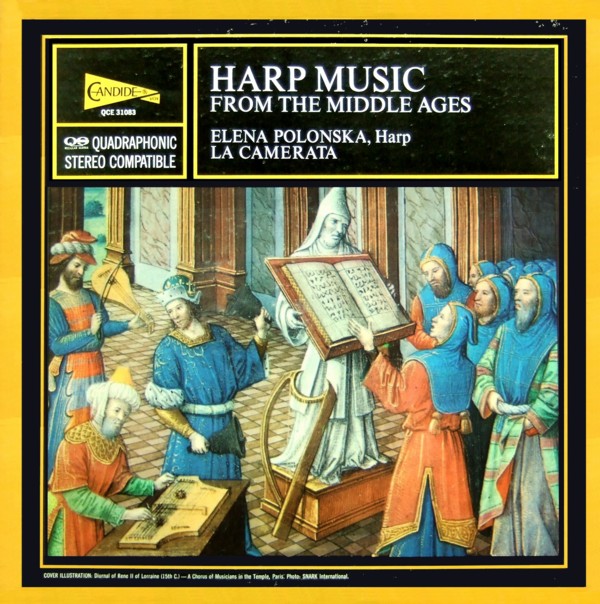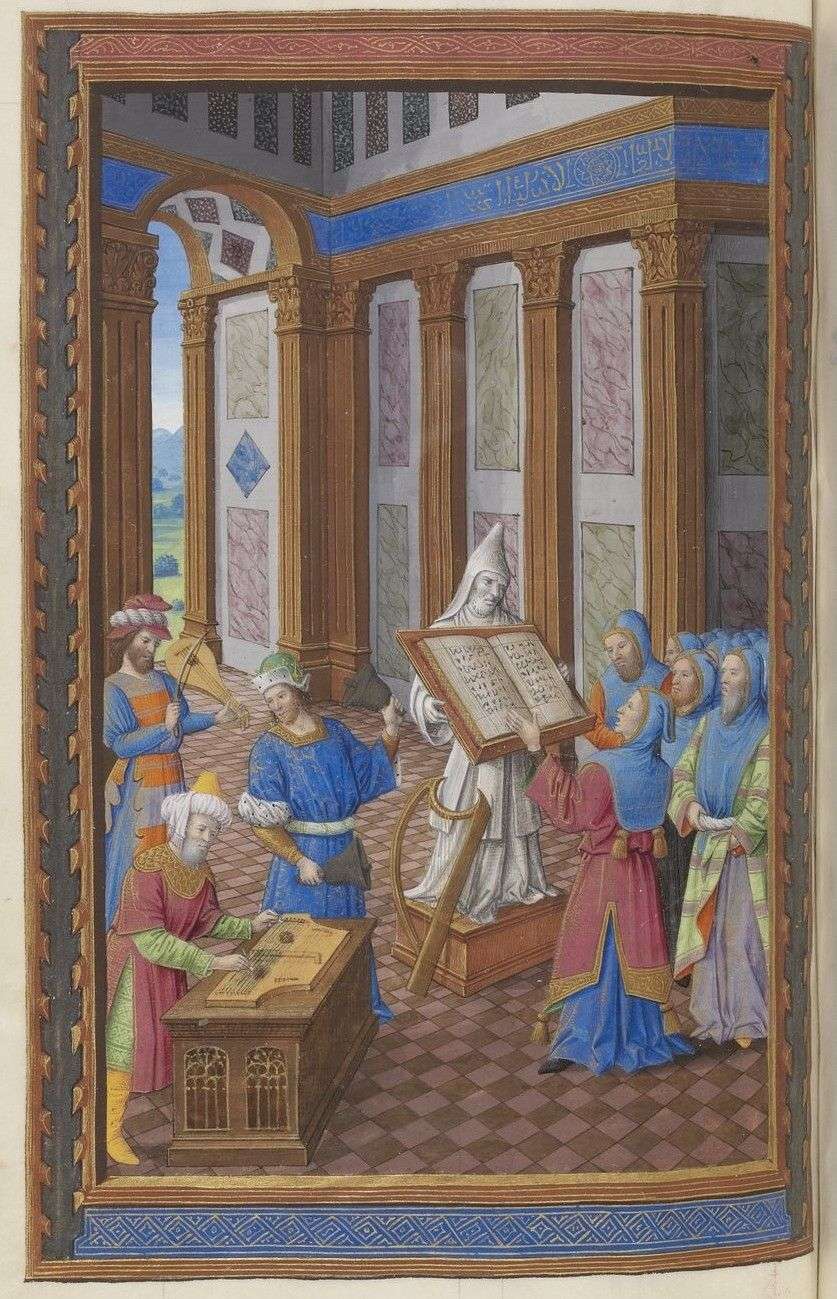
medieval.org
Turnabout TV 34871
1973
Candide QCE 31083 / Candide (FSM) CE 31083
FSM 53016
1974

medieval.org
Turnabout TV 34871
1973
Candide QCE 31083 / Candide (FSM) CE 31083
FSM 53016
1974
SIDE I [20:31]
Band 1 [6:50]
1. Anon. (13th cent.). Estampie anglaise [1:56]
— vièle, recorder, Irish harp, zarb
2. Blondel de NESLE (12th cent.).
A la entrée de l'esté [1:15]
— Irish harp
3. Notre Dame School (ca. 1250). Motet Pucelete [0:48]
— medieval harp, lute, recorder
4. THIBAUT IV, king of Navarre (ca. 1201-1253).
Pour ce se d'amer me dueil [1:26]
— vièle, percussion
5. Anon. (13th cent.). Elend, du hast umfangen mich [1:26]
— Irish harp
Band 2 [8:01]
6. Anon. (13th cent.). Istampitta Ghaetta [4:02]
— recorder, medieval harp, zarb, tambourine
7. Gautier de COINCY (12th cent.).
Ma vièle [1:43]
— vièle, Irish harp,
8. Alfonso X "The Wise" (1221-1284).
Cántiga [1:10]
CSM 166
— psaltery, percussion
9. Anon. (13th cent.). Danse royale [1:06]
— Irish harp, percussion
Band 3 [5:40]
10. Magister PIERO (14th cent.).
Chavalcando con un giovin accorto [1:32]
— Irish harp, lute
11. Giovanni da FLORENTIA (ca. 1330).
Io son un pellegrino [2:00]
— Irish harp, lute
12. Francesco LANDINI (1325-1397).
Nel mio dolce sospir [2:08]
— Irish harp, lute, recorder
SIDE II [16:46]
Band 1 [6:06]
13. Raimbault de VAQUEIRAS (?-1207?).
Kalenda maya [2:19]
— vièle, recorder, Irish harp, zarb
14. Notre Dame School (13th cent.). Clausolae Haec dies [1:56]
— Irish harp
15. Anon. (13th cent.). Saltarello [1:52]
— rebec, recorder, Irish harp
Band 2 [6:01]
16. Anon. (13th cent.). Chanson de Toile [1:25]
— medieval harp
17. Oswald von WOLKENSTEIN (1377-1445).
Wach auff, myn hort [0:58]
— vièle, lute
18. Anon. (13th cent.). En mai la rousée [1:06]
— medieval harp
19. Notre Dame School (13th cent.). Flos filius eius [1:06]
— medieval harp, psaltery, vièle
20. Anon. (13th cent.). La Rossignol [1:07]
— recorder, rebec, medieval harp
Band 3 [4:39]
21. Bernart de VENTADORN (12th cent.).
"Vers" provençal [2:32]
— Irish harp
22. Anon. (13th cent.). Estampie royale [1:46]
— recorder, vièle, Irish harp, tambourine
23. Anon. (13th cent.). Trop penser me font amours [1:116]
— medieval harp
24. Anon. (13th cent.). Estampie royale [0:36]
— schalmey, vièle, percussion
" I must point out that I have specially chosen the pieces which are here recorded
for their agreeable and entertaining character;
and although this music is from the distant past, I feel that the listeners in listening to it
will derive the same pleasure as the interpreters did in playing it."
(Elena Polonska)
The role of instruments in the music of the Middle Ages is not clearly
defined: bowed instruments, plucked instruments and wind instruments
were numerous; and we know very little about the percussion instruments.
The vièle was the principal instrument with which the jongleur
was pictured. There is no doubt that instruments could accompany and
double the voice or voices and also that they could play all the voices
of a song as a purely instrumental composition, as was authorized by
Guillaume de Machaut himself for his ballads. The instruments used on
this record are as follows:
"I cannot too much compare my Lady
The
dance in the Middle Ages was as much a fundamental activity in the
market place and at secular festivals as it was in the church: danses macabres,
pictured in sometimes very realistic tableaux, Saint Vitus' dances,
etc. There was no event which was not an occasion, in both noble and
humble dwellings, to express one's joy, one's sadness or one's fear by
gestures. The French theoretician Jean de Grouchy: in a treatise written
around 1300 describing the different genres of secular music, declared that there were
three instrumental dance forms: the estampie, the ductia and the nota;
their compositional principles were all the same
(several different sections or puncta, which were each repeated).
In general, the estampie possessed a greater number of puncta than the ductia or the nota,
whose rhythms were accentuated by a percussion instrument. Note
repetitions, leaps of a fourth or a fifth and very short ornaments were
characteristic of the estampie Royale (French) and the Italian istampita "Ghaetta,"
named after the port city of Gaete. Clearly the nota had a more rugged character,
with a simple four-square melody. The famous estampie "Kalenda maya"
of the troubador-knight Raimbault de Vaqueiras (d.1207), vassal of
Boniface de Montferrat, was improvised, it is said, on the melody of an
instrumental estampie that two jongleurs had just played
on the vièle: its melody is languorous, supple and unhurried like the
Provençal poetry of Bernart de Ventadorn, without doubt the most
melancholy and inspired of the troubadours.
The upper voice includes the following words: Elena Polonska and Gérard Fleury.

LA CAMERATA
Elena Polonska, medieval harp, Iris harp, percussion
Nives Poli-Rapp, lute, psaltery & percussion
Steve Rosenberg, recorders, schalmey
Jacques Manzone, viéle, rebec, percussion
Daniel Dossmann, zarb, tambourine
COVER ILLUSTRATION:
Diurnal of Rene II de Lorraine (15th C. - A Chorus of Musicians in the Temple, Paris)
Photo: SNARK International
℗ 1974 VOX PRODUCTIONS, New York
.jpg)
1. The vièle de bras (from the
Provençal word "viola" or "viula") is a bowed instrument with a
soundbox in the shape of a slightly elongated oval, sometimes slightly
notched, with a flat bottom and 3 to 5 strings.
2. The rebec (from the Arabic "rebab"), a small bowed instrument with a slightly rounded tapering body and 3 strings.
3. The recorder family or flauti dolci.
4. The soprano schalmey is a member of the double reed family of instruments, ancestors of the oboe..
5. The psaltery, a plucked instrument with strings stretched over a soundboard and played by one or two plectra.
6. The lute
is probably an instrument of Arabic origin. with an angled fingerboard,
doubled strings, a soundboard pierced by a rose and a curved body.
According to the "Cantigas de Santa Maria," it appeared in the 10 th
century.
7. The zarb, a Persian percussion instrument, as well as little cymbals and tambourines.
8.
The harp, the most ancient of all instruments along with the flute, in
its Medieval version of metal strings and a form resembling the harp of
the Irish king Brian Boru (12th century), and its Irish version, with
gut strings. Very much in fashion among the Egyptians, the Hebrews and
the Greeks (even though it was proscribed in the time of Pericles, since
the philosophers had declared its voluptuous and sensual character to
be dangerous to morality), its appearance in Europe is attributed to the
Scandinavians, Teutons and Celts. Already by the 12th century, the
refinement of construction of the Irish harp was extreme (the number of
strings varied from 7 to 30), and harpists, such as the famous Blondel
de Nesle, harpist to Richard the Lion-Hearted, enjoyed great favor. The
harp not only inspired the plastic arts, but also gave birth to a whole
school of symbolic poetry. Dante mentions it in his "Paradise" and
Guillaume de Machaut mentions it in his more worldly evocations, such as
in the following poem:
To the harp, with its lovely body adorned
With twenty-five strings, as was the harp
Which King David many times played."
The polyphonic genre
(in 2 voices) of the Italian "ballata" (derived from the French
"virelai") is represented by a composition of Giovanni da Florentia
(d.1351) and also by a piece by the specialist of this genre, Francesco
Landino (d.1397), known as the "Cieco degli organi" (The Blind
Organist). He was one of the most remarkable masters of the Ars Nova,
who composed more than 140 ballads in 3 voices including ones such as
the example on this recording, written in an expressive style, with
great rhythmic subtlety and full of sentimental sweetness (the text
begins with "Nel mio dolce sospir . . ."). The term "madrigal" is
derived from the expression cantus materialis (as opposed to the cantus spiritualis)
and designates a song whose aim is to entertain and amuse during
periods of relaxation: the one recorded here is by Magister Piero, a
composer in the service of the Visconti family in Milan and the
Scaglieri family in Verona; he is probably the inventor of the canonic
madrigal and his style is distinguished by the abundant use of unisons,
parallel fifths and octaves.
A chanson de toile (lit.
"linen song"), with a monotonous litany-like character such as women
used to sing while weaving, and three other anonymous songs ("Le
Rossignol," "En mai la rousée," and the beautiful complaint [b]"Trop penser
me font amours") lead us to the subject of the trouveurs, a general term designating the troubadours
of the South and the trouvères of the North.
Let us remember that the profession of trouveur,
which is to say a highly esteemed composer-poet, was clearly differentiated from that of jongleur,
the wandering entertainer who was later to become the minstrel-musician
with a permanent position at Court or in the retinue of a noble.The
troubadour Bernart de Ventadorn and the trouvère Thibault IV de
Champagne, the very learned and cultivated king of Navarre (d.1253 at
Pampelune) reveal to us the secrets of their art, the former in the
melody whose languorous character we have already emphasized, the latter
in a sort of free-style lamento ("Pour ce se d'amer me dueil"), although the trouvère melodies
were usually more rhythmically strict.
To these we must add two others: Blonde! de Nesle with his melancholy song "A l'entrée de l'esté"
and Gauthier de Coincy, a monk and prior at Saint Médard de Soissons
and the author of the "Miracles de Notre Dame," "an immense cycle of
stories in verse which display his emotional, ardent and almost sickly
temperament" (Jacques Chailley), from which is excerpted the song "Ma vièle".
The king of Castille and León, Alfonso X "The Wise" (1221-1284), a
great patron of the arts, imitated Gauthier de Coincy in his "Cántigas de Santa Maria,"
a collection of 428 religious poems dedicated to the Virgin, some of which are of his own composition.
Oswald von Wolkenstein (d.1445) and the Deutsches Lied "Elend du hast mich umfangen"
follows the tradition of the German Minnesänger, whose style recalls
that of the French Ars Nova which first appeared around 1150 under the
influence of the Provençal troubadours who it will be recalled,
travelled a great deal.
After a clausolae, a kind of polyphonic composition built on a short excerpt from a song ("Hace Dies"
in this case) and treated in the concise style of Pérotin (the greatest
of the Notre Dame School composers), there follow two interesting
examples of the "profane" motet of the 12th century, "Flos filius" ' and "Pucelete".
The compositional procedure is simple: a portion of an organum
is chosen where the tenor voice (written in long rhythmic values) is
fastest, or where its rhythm is closest to that of the other voices, the
words being in close rapport with the tenor as to their meaning.
However, as this genre evolved, the words became secular and no
longer had any relation to the words of the tenor part, as in the case
of the following:
"Pucelete bele et avenant joliette" (Beautiful and lovely young girl)
The middle voice recites:
"Je languis des maus d'amour ..." (I languish front the pain of love ...
The tenor (in long rhythmic values):
"Domino" (to God)
Edited and translated by PETER TRACTON
